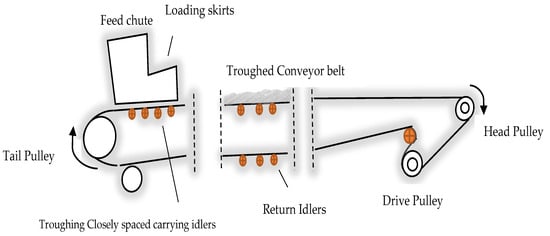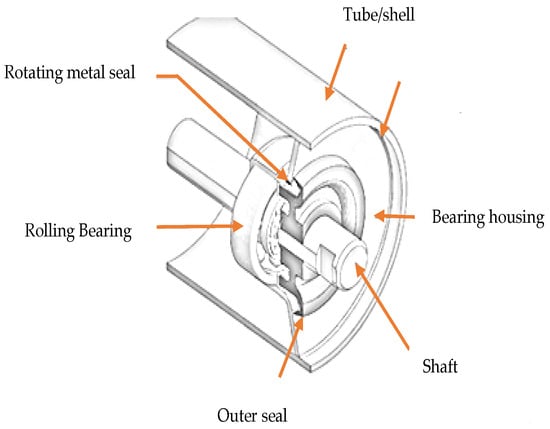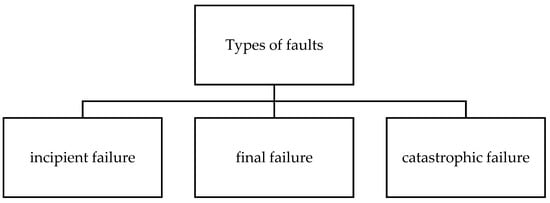Your browser does not fully support modern features. Please upgrade for a smoother experience.
Please note this is an old version of this entry, which may differ significantly from the current revision.
Bulk materials are transported worldwide using belt conveyors as an essential transport system. The majority of conveyor components are monitored continuously to ensure their reliability, but idlers remain a challenge to monitor due to the large number of idlers (rollers) distributed throughout the working environment. These idlers are prone to external noises or disturbances that cause a failure in the underlying system operations.
- belt conveyor idlers
- conveyor systems
- fault detection
1. Components of a Belt Conveyor
The belt on roller conveyor systems is considered one of the many conveyor systems available [29]. These systems consist of several continuously monitored components to maintain their reliability. Figure 1 illustrates the belt on roller conveyor systems with a belt spanned between a head and a tail pulley [30]. The head pulley is connected to a drive unit that consists of an electric motor, multiple couplings, and a gearbox. One of the most important components of a drive unit is the gearbox [31]. According to [32], 14% of gearboxes need to be replaced yearly due to unexpected failures. Wear or damage to the geared wheels (broken teeth or excessive backlash) and bearing failures (due to fatigue of outer/inner races and rolling elements) are the causes of these failures.

Figure 1. Structure of a belt Conveyor.
In order to support the load of the bulk material on the belt, spatially distributed carrying idlers support the belt along its length [17]. A report indicates that more than half of conveyor belt failures are caused by malfunctioning idlers [33]. The idler is one of the most common rotating components in belt conveyor systems. Load-bearing idlers are also referred to as return and carry idlers [2]. Each idler roller consists of a shell, shaft, two bearings and housings, and two sealing systems. Figure 2 shows the typical structure of belt conveyor idlers. A significant part of the roller’s performance is the bearings, considered one of the most important components of the roller that contribute to the reliable operation of the idler rolls [34]. To better understand the belt conveyor idlers components, it is necessary to understand the type of faults that arise from such components.

Figure 2. Structure of belt conveyor idler.
2. Source of Faults in the Belt Conveyor Idlers
Due to their rotating nature, when functional failures occur in components of belt conveyors, such as idlers, pulleys, and gearboxes, they generate noise that can be measured vibrationally or acoustically [19,35]. Idlers are generally believed to be the primary noise source in belt conveyor systems in acoustic and vibration methods [19,33]. Figure 3 illustrates the use of idler rolls on a typical belt conveyor.

Figure 3. Idler rolls are shown in operation on a typical belt conveyor.
Idler roll failures can be classified into three types: incipient failure, final failure, and catastrophic failure, as depicted in Figure 4 [36]. A large amount of the literature on the detection system (FD) of belt conveyor idlers falls between the stages of incipient failure and final failure. According to [36], incipient failure refers to spalling or fatigue on the bearings that occurs when rolling elements wear out due to pitting, fretting, abrasive or adhesive wear. Before the incipient failure occurs, bearings in rollers are functioning correctly and are in a healthy condition. The rollers will last as long as the bearings last [37]. Then, bearing fatigue occurs when rolling elements wear out due to pitting, fretting, abrasive or adhesive wear. Factors such as lubrication, dust, and moisture can affect the bearings [38,39]. These incipient failures can lead to or develop into final faults, such as impermissible noise emission, excessive runout, a seized roller, or even bearing collapse states.

Figure 4. Types of failures in belt conveyor idlers.
For example, Liu et al. [8] investigated the incipient failures acoustically of three types of artificially defected bearings, including the damaged bearing, cage, and cover, which have been found to cause serious and final conveyor system failures. Using the audio-based method, Peng et al. [24] studied the roller in the context of three types of failures. Similarly, rollers have been studied [40,41] in binary classification between normal and faulty conditions based on several scenarios, including broken rollers, rotation off-center, collisions, and friction between the belt and the roller. Different approaches have been taken to study the rollers using robots [42,43] which successfully detected the defective idlers. Roos and Heyns [23] used a vibration signal method to investigate incipient faulty idler bearings at three lateral positions on the belt: near the faulty bearing, in the middle of the belt, and over the healthy bearing. Another study [44] analyzed a vibration signal anomaly caused by a defect in the roller bearing, friction between the belt and the blocked tracking roller, and abrasion of the roller tube. Several other studies by Ravikumar et al. [45,46,47,48] investigated the vibrations of an incipient faulty idler as part of the multiclassification task to train different ML models. Idlers that are incipiently failing can still perform their functions until they fail. Several rollers must be observed to prevent belt failures from causing a fire and causing a catastrophic event. Catastrophic failure refers to idlers that have failed severely and cannot function properly, which may result in severe damage to belt conveyor systems, such as fire. Idlers in the final or catastrophic failure stage will produce more thermal infrared radiation due to the increase in resistance [7]. Idlers can generally be affected by three major defects: breaking, overheating, and seizing.
3. Fault Detection
A fault detection system (FD) for industrial processes is designed to produce an effective indicator that can identify faulty processes and prevent future failures or unfavorable events [9]. For example, the petrochemical industry loses approximately 20 billion dollars annually due to faults in its machine components [49]. Likewise, according to a report, approximately 60% of the cost of aircraft engine components is attributed to maintenance [49]. In the worst-case scenario, a malfunctioning machinery component may result in the death of a human being.
The process of diagnosing faults can be divided into four stages: fault detection, fault identification, fault severity assessment, fault growth and remaining useful life prediction [22]. The process of fault detection involves the examination of the components of machinery for faults. Based on the previous section, most research on fault detection is concerned with incipient faults in idlers to enable the next stage of the FD process to be performed. A fault identification process involves locating and identifying the type of fault in machinery components. Wijaya et al. [12] proposed a combination of a statistical analysis based on vibrational signal and unsupervised ML models to determine the fault location of belt conveyor idlers. The size of the fault determines the severity of a fault in the belt conveyor idler. This can be estimated by extracting statistical information from idlers. In the remaining useful life (RUL) process, the life cycle of a machine component is predicted. A fault’s growth is predicted based on the size of the fault after a certain number of cycles. RUL analysis predicts the breakdown period/time of the component. In an FD system, this analysis might be beneficial if the output RUL prediction is expressed as a function of time and fault size. Our investigation indicates that most of the literature has been devoted to studying the first stage of fault diagnosis. Therefore, the review will focus on fault detection since studies on fault identification, fault severity, and useful life prediction have not yet been completed regarding belt conveyor idlers.
This entry is adapted from the peer-reviewed paper 10.3390/s23041902
This entry is offline, you can click here to edit this entry!
